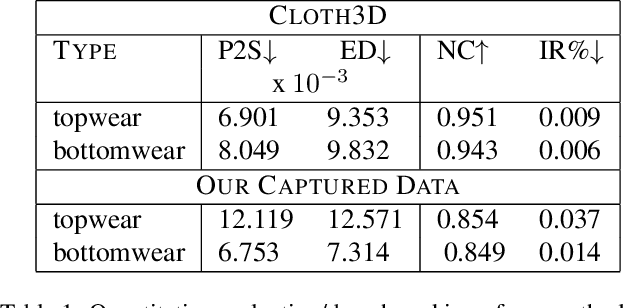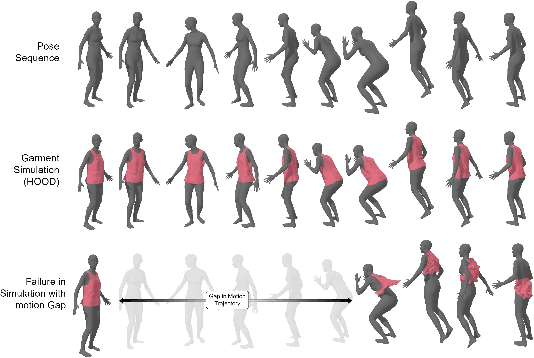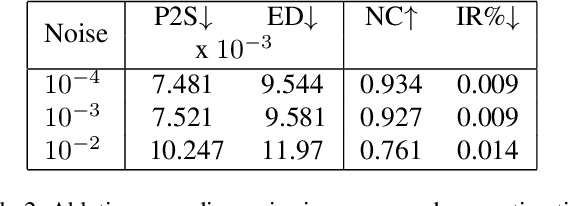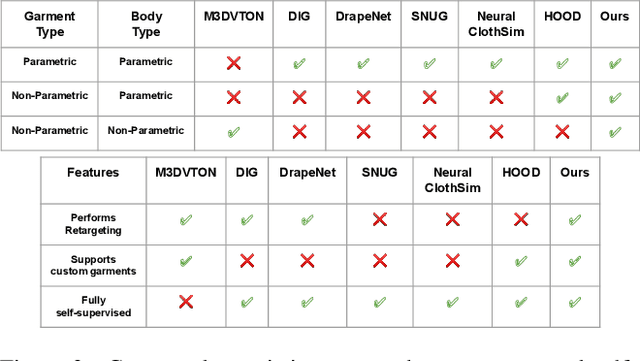Shanthika Naik
NGD: Neural Gradient Based Deformation for Monocular Garment Reconstruction
Aug 25, 2025Abstract:Dynamic garment reconstruction from monocular video is an important yet challenging task due to the complex dynamics and unconstrained nature of the garments. Recent advancements in neural rendering have enabled high-quality geometric reconstruction with image/video supervision. However, implicit representation methods that use volume rendering often provide smooth geometry and fail to model high-frequency details. While template reconstruction methods model explicit geometry, they use vertex displacement for deformation, which results in artifacts. Addressing these limitations, we propose NGD, a Neural Gradient-based Deformation method to reconstruct dynamically evolving textured garments from monocular videos. Additionally, we propose a novel adaptive remeshing strategy for modelling dynamically evolving surfaces like wrinkles and pleats of the skirt, leading to high-quality reconstruction. Finally, we learn dynamic texture maps to capture per-frame lighting and shadow effects. We provide extensive qualitative and quantitative evaluations to demonstrate significant improvements over existing SOTA methods and provide high-quality garment reconstructions.
Thin-Shell-SfT: Fine-Grained Monocular Non-rigid 3D Surface Tracking with Neural Deformation Fields
Mar 25, 2025Abstract:3D reconstruction of highly deformable surfaces (e.g. cloths) from monocular RGB videos is a challenging problem, and no solution provides a consistent and accurate recovery of fine-grained surface details. To account for the ill-posed nature of the setting, existing methods use deformation models with statistical, neural, or physical priors. They also predominantly rely on nonadaptive discrete surface representations (e.g. polygonal meshes), perform frame-by-frame optimisation leading to error propagation, and suffer from poor gradients of the mesh-based differentiable renderers. Consequently, fine surface details such as cloth wrinkles are often not recovered with the desired accuracy. In response to these limitations, we propose ThinShell-SfT, a new method for non-rigid 3D tracking that represents a surface as an implicit and continuous spatiotemporal neural field. We incorporate continuous thin shell physics prior based on the Kirchhoff-Love model for spatial regularisation, which starkly contrasts the discretised alternatives of earlier works. Lastly, we leverage 3D Gaussian splatting to differentiably render the surface into image space and optimise the deformations based on analysis-bysynthesis principles. Our Thin-Shell-SfT outperforms prior works qualitatively and quantitatively thanks to our continuous surface formulation in conjunction with a specially tailored simulation prior and surface-induced 3D Gaussians. See our project page at https://4dqv.mpiinf.mpg.de/ThinShellSfT.
Dress-Me-Up: A Dataset & Method for Self-Supervised 3D Garment Retargeting
Jan 06, 2024



Abstract:We propose a novel self-supervised framework for retargeting non-parameterized 3D garments onto 3D human avatars of arbitrary shapes and poses, enabling 3D virtual try-on (VTON). Existing self-supervised 3D retargeting methods only support parametric and canonical garments, which can only be draped over parametric body, e.g. SMPL. To facilitate the non-parametric garments and body, we propose a novel method that introduces Isomap Embedding based correspondences matching between the garment and the human body to get a coarse alignment between the two meshes. We perform neural refinement of the coarse alignment in a self-supervised setting. Further, we leverage a Laplacian detail integration method for preserving the inherent details of the input garment. For evaluating our 3D non-parametric garment retargeting framework, we propose a dataset of 255 real-world garments with realistic noise and topological deformations. The dataset contains $44$ unique garments worn by 15 different subjects in 5 distinctive poses, captured using a multi-view RGBD capture setup. We show superior retargeting quality on non-parametric garments and human avatars over existing state-of-the-art methods, acting as the first-ever baseline on the proposed dataset for non-parametric 3D garment retargeting.
Deep Generative Framework for Interactive 3D Terrain Authoring and Manipulation
Jan 07, 2022



Abstract:Automated generation and (user) authoring of the realistic virtual terrain is most sought for by the multimedia applications like VR models and gaming. The most common representation adopted for terrain is Digital Elevation Model (DEM). Existing terrain authoring and modeling techniques have addressed some of these and can be broadly categorized as: procedural modeling, simulation method, and example-based methods. In this paper, we propose a novel realistic terrain authoring framework powered by a combination of VAE and generative conditional GAN model. Our framework is an example-based method that attempts to overcome the limitations of existing methods by learning a latent space from a real-world terrain dataset. This latent space allows us to generate multiple variants of terrain from a single input as well as interpolate between terrains while keeping the generated terrains close to real-world data distribution. We also developed an interactive tool, that lets the user generate diverse terrains with minimalist inputs. We perform thorough qualitative and quantitative analysis and provide comparisons with other SOTA methods. We intend to release our code/tool to the academic community.
 Add to Chrome
Add to Chrome Add to Firefox
Add to Firefox Add to Edge
Add to Edge